A scene from Modern Family:
Manny and Jay are working on a project. Manny prepares a snack, which happens to be an artful display of prosciutto with slices of melon, olives, the works. Jay is eyeing it appreciatively when Manny says: “don’t touch the charcuterie yet.”
Jay looks dumbfounded. “That’s what it’s called? If I had known that, I would have been ordering it in restaurants a long time ago.”
Charcuterie is the art of making sausages and other cured, smoked and preserved meats. In addition to sausages, classic charcuterie items include pâtés, terrines, hams, bacon, salami, galantines, torchon, head cheese, and the like.
Classic French cooking leaves the making of charcuterie to the garde manger, but its origins go back much further. Every culture used salt, brine and air to preserve food without refrigeration.
Several we eat today without much thought — the beautiful air-cured hams of Italy such as Parma, Ukrainian kubasa, Polish sausage, Italian salami, German wurst.
If you can brine it, cure it, or grind it into a forcemeat and pack into a casing, you can call the finished product charcuterie, whether it’s made from pork, beef, poultry seafood, vegetables, even tofu.
And it’s back, in a big way. We are having a charcuterie moment. Several Edmonton restaurants are laying out impressive charcuterie plates.
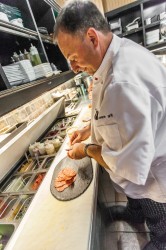
The Hardware Grill’s charcuterie plate combines several house-made pâtés and terrines with unusual, fine quality products from local suppliers. A recent plate had mipkuzola (air-dried musk ox, a delicacy from the Canadian north via Hills Brothers), white deer salami from Rocky Mountain Game Meats in Calgary, and a spicy Abruzzo sausage from the Italian Centre.
“We also like Valbella meats in Canmore,“ says exec chef Larry Stewart.
“We make all our own pickles: carrots, beets and pearl onions using fresh herbs such as dill and rosemary. We make pork rillette, a wild boar terrine with ham hock and pistachios. We make a truffled mortadella or with pistachios, always something different.
“We’re working on cheese right now — a nice dependable ricotta and we’ll work up from there. “
Andrew Cowan at Hundred Bar and Kitchen is creating the most inventive charcuterie boards, with kobe bresaola, cured pork loin, a rillette and a terrine of some sort, bacon jam and house made mostarda and pickled farmers market veg.
“I love these really old school techniques — it’s fun for me trying different flavours with the cures. We don’t have the set up for salami, as it ferments as well as cures. Right now, I’m sticking to whole muscle, such as pastrami. I can save a bit of money doing my own and I can use local product, such as custom cuts from Irvings with extra fat cap.
“When I make terrines and pâtés I use old school techniques with new school flavours, with bison, venison or kobe beef, and blueberry or saskatoons, or use Scotch instead of Cognac. There are so many options; it doesn’t have to be covered in pastry. We make rillette which is essentially an extremely rustic pâté — we will confit pork belly and run it right down the middle, so delicious. I made kobe bresaola with togarashi spice, or with some nice peppers, even truffled it once. “
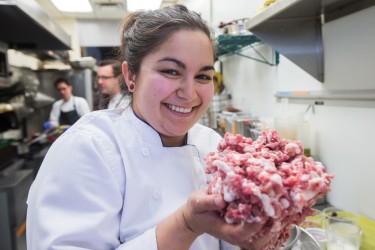
Andrew is not averse to new school technique. He’s making terrine using a sous-vide machine. “The immersion circulator captures perfect temperature. We end up with better flavour and fat emulsion.”
Patrick Saurette of the Marc says making charcuterie in house is a natural extension of what their kitchen is doing, making everything from scratch.
“I love a working man’s pâté with the nice big chunks of meat, substantial with great flavours. This style reminds me of the pork liver pâté my grandfather made at Christmas: two pounds pork liver, two pounds pork fat, two pounds ground pork, chopped onions, white with salt and black with pepper, all-spice nutmeg.
”You can tell it’s an old recipe from when they would slaughter the pig, the liver would be about two pounds.
“We’re just delving into sausage making. We make bratwurst, we think we make a fantastic chorizo. My mission is to nail merguez. These are foods you eat in the colder months. In January and February we’re going to focus on the foods of the Alsace — lots of sausage; foods that make your feet swell.”
Filliep Lament of Three Boars grew up eating good charcuterie.
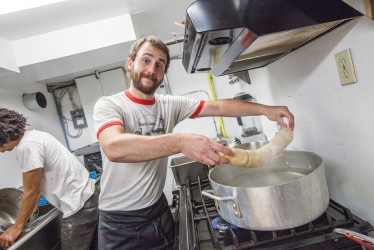
“I’m from a Polish family. I would go to my uncle’s in Poland. He would kill the pig, cut it, cure it and smoke it with the special wood he had. The bacon and ham that he made is the benchmark for me.”
Three Boars focuses on terrine and pâtés.
“We don’t do a lot of smoking, and dry cure, there’s no way we’ll touch it, we don’t have the facility.
“We have a lot of plans. We’re always looking for more terrine ideas but it’s not just about taking some weird meat, chopping it up and putting it in a terrine. We tried using beef tongue but the texture did not feel good when it was cold. Pork terrine can vary a lot. We use pork tongue, lamb liver, tons of back fat. Or we can make a seafood terrine or vegetable terrine.
“We really like duck rillette, both making it, and eating it.
“We always confit the legs. Sometimes it ends up in rilletes, or as part of a composed dish.
”We made some bacon with lamb belly. Jeff from Sangudo brought us some lamb cheek and lamb tongue, but we might just eat that, two or three pieces in a cheek and tongue sandwich.”
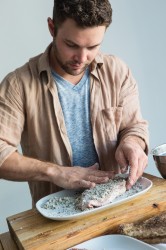
Ben Chalmers at Corso 32 makes several Italian salumi such as mortadella, coppa di testa (similar to head cheese), pork cheek terrine, bresaola, (air dried beef) and lonza (Italian cured pork loin).
“We love guanciale, a salt cured pork jowl. It is lightly salty with a delicate fat and beautiful flavour (as opposed to pancetta, as the fat is less worked). Guanciale is meant to be cooked. Sauté it off, the crispness around the fat is good. It’s a Lazio specialty — they’ll use it in carbonara, always bucatini Amatriciana, spaghetti and alla grechia spaghetti with black pepper and guanciale.”
It was a delicate and flavourful mortadella served at the Marrotti Campi dinner last spring that had people talking.
“Mortadella is from Bologna, traditionally done with pistachios and originally made with donkey meat; a frugal mixture of donkey and pig,” says Daniel Costa chef/owner corso 32.
“We make our mortadella with nutmeg, salt, whole peppercorns, pistachios, coriander and honey. We serve it sliced very thin, or cut it into cubes. Basically, it’s a giant emulsified slow-poached sausage. To make it properly, you must have a good heavy duty food processor, like a commercial robot coupe. We use a sous-vide to cook slowly and thoroughly.
Mortadella flavours a lot of pasta fillings, says Daniel. As in spuma di mortadella, pureed with cream, tortellini and Bolognese sauce.
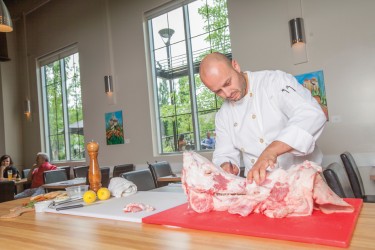
The charcuterie board at cibo in Oliver Square changes often, whenever the chef/owner Rosario Caputo decides to try a new form of Italian salumi.
The star of the night is porchetta di testa (essentially, cured pork face). Rosario purchases a pig’s head from Irvings, carves it, and rubs with a salt/sugar herb blend to start the long process. The result is a deliciously salty, slightly sweet pork charcuterie with the texture of very good Parma ham.
“Right now we’re making a pig’s head mortadella with pistachio and peppercorn,” says Rosario. Usually we would use shoulder, but we’re finding that the mortadella sets up better this way. We make lonza, a cured pork loin. I love making lardo. It spends weeks in the cure, then hangs for another three. The texture is so silky and velvety.
“It’s a new experience for some of our kitchen staff. We’re thinking of doing prosciutto, from leg of lamb, though it has to hang for 120 days. Making our own is always a trade-off between time and money, but the flavour is better when we do it ourselves.
Charcuterie
Because it’s such a wonderful catch-all term, charcuterie is used to describe all manner of things:
Pâtés
A smooth mixture of seasoned ground meat (often liver) and fat often topped with aspic or more fat to help preserve it. Pâté en croute has a pastry top. A delicious treat.
Rillette
Cooked meat (originally pork belly, shoulder or game birds) mixed with fat to create a spreadable texture.
Terrines
Similar to a pate but generally chunkier and layered. Also the dish a terrine or pate is placed in.
Galantine
Deboned chicken stuffed with a ground meat mixture, wrapped in its own skin, and then cooked. Turducken would be a galantine of sorts. A ballotine is a leg made in the same fashion.
Confit
Cooking something at a low temperature in its own fat, then storing the meat in this fat in a covered container. Eg. duck confit.
Crépinette
Coarse meat mixture wrapped in caul fat. Very savoury.
Salami
Cured, air-dried and fermented. Salami are often covered in mold, either naturally or injected, which prevent spoliage and imparts a unique regional flavour.
Salumi
Italian charcuterie.